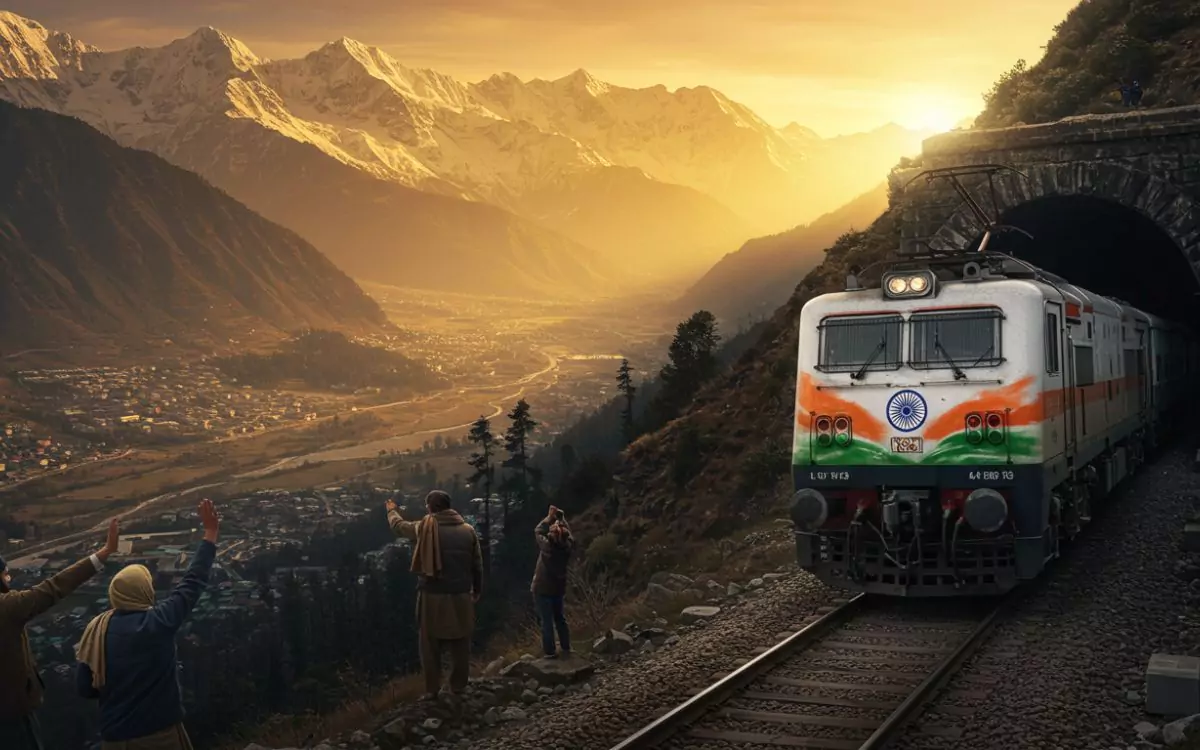For many of us, a train ride is just a normal part of life. But in Kashmir, that ride has been a dream for more than a hundred years. Now, that dream is finally becoming real.
Later this month, something big is going to happen. A new part of the railway track—stretching 63 kilometers from Katra to Sangaldan—is all set to open. Once that happens, trains will run all the way from Jammu to Kashmir without a break. And that means people won’t have to rely only on roads anymore, especially during bad weather when routes often get blocked.

But this isn’t just about new tracks and trains. This is about history, effort, and patience that goes back to the 1800s.
The First Steps, a Century Ago
Back in 1889, a British army officer named Raoul De Bourbel first thought of laying train tracks toward Kashmir. He looked into building a line from Jammu to Akhnoor. A few years later, a small track was built from Jammu to Sialkot (which is now in Pakistan). But the main goal—to connect the Kashmir Valley—still felt far away.
In 1898, Maharaja Pratap Singh of Jammu & Kashmir wanted to bring a railway into the Valley. He believed it would help the region grow. The British government agreed, but building a railway through mountains was no small task. Surveys were done, and many paths were considered, including one that would pass through the famous Mughal Road. But none of them took off.
Even in 1905, another proposal was made to connect Srinagar and Rawalpindi by train. Again, it didn’t move forward.
Too High, Too Hard
One of the biggest challenges was the terrain. The mountains around Kashmir, especially the Pir Panjal range, are steep and dangerous. A narrow-gauge electric train route was even discussed once, meant to climb those sharp heights. But it would have cost too much and wouldn’t be reliable year-round.
Coal was found in the Ladda area of Jammu in the early 1900s, and people hoped it could help power the trains. But mining coal from such tough land turned out to be more trouble than it was worth. So the idea went quiet for a long time.
Lost in Time
In 1928, the idea came up again. Experts from the Geological Survey of India thought it was worth exploring. But due to lack of interest and support, that plan also faded away.
More efforts were made in the 1930s. A retired railway official even walked the land to figure out a good route. But the only real progress was the small line already built from Jammu to Sialkot.
Then came World War I, followed by World War II. With all attention on the wars, the railway dream slipped further away. After the Partition in 1947, the Jammu-Sialkot route was cut off completely.
After Independence
After India gained independence, the dream got a fresh start. In 1952, a railway track reached Pathankot. Engineers kept looking for good routes into the hills. In the 1960s, a study showed that a route from Kathua to Udhampur might work. But even that didn’t make financial sense at the time.
Things finally started picking up in 1969, when work began to extend the track to Jammu. By 1972, the line from Kathua to Jammu was ready for goods trains. And just two months later, the Srinagar Express began its journey from Pathankot to Jammu.
Despite war with Pakistan in 1971, construction did not stop. That kind of commitment was rare. In 1983, then Prime Minister Indira Gandhi laid the foundation for the Jammu to Udhampur line. It was slow progress, but it was real.
Moving Closer, Bit by Bit
In 1994, plans were made to extend the line further into Kashmir. The idea now included reaching Baramulla. New sections were slowly approved—Udhampur to Katra, Katra to Qazigund, and so on.
In 2002, Prime Minister Atal Bihari Vajpayee called the Kashmir rail project a “national priority.” It was no longer just a dream—it was something the whole country wanted to see happen.
The train line began opening in small parts:
- In 2008, the Anantnag to Mazhom stretch opened.
- In 2009, two more parts opened—from Mazhom to Baramulla and from Qazigund to Anantnag.
- In 2013, the Qazigund to Banihal part was done.
- In 2014, PM Modi launched the Udhampur to Katra route.
- And in 2024, the Sangaldan to Banihal stretch was completed.
Now, only one last piece—Katra to Sangaldan—is left. And that’s exactly what’s about to open.
What It Means for People
This isn’t just a railway line. It’s something that brings hope. For locals, it means easier travel, better trade, and faster connections to other parts of India. For tourists, it makes reaching Kashmir safer and simpler. And for the country, it’s a symbol of what can be achieved with time, patience, and teamwork.
The train to Kashmir is more than steel and concrete. It’s a reminder that even the longest journeys can reach their destination—one step at a time.